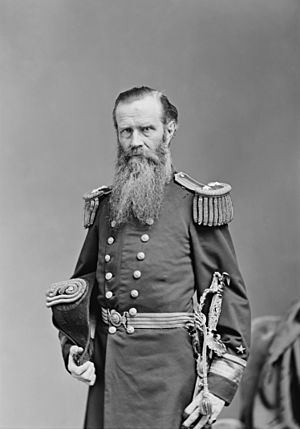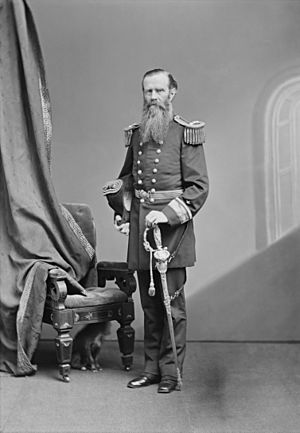John Lorimer Worden facts for kids
Quick facts for kids
John Lorimer Worden
|
|
|---|---|
 |
|
| Born | March 12, 1818 Mount Pleasant, New York |
| Died | December 19, 1897 (aged 79) Washington, D.C. |
| Place of burial | |
| Allegiance | United States of America |
| Service/ |
United States Navy Union Navy |
| Years of service | 1834–1886 |
| Rank | |
| Commands held | USS Monitor USS Montauk United States Naval Academy European Squadron |
| Battles/wars | Mexican–American War American Civil War |
John Lorimer Worden (born March 12, 1818 – died October 19, 1897) was a brave officer in the United States Navy. He is most famous for his role in the American Civil War. He commanded the ironclad ship USS Monitor during the historic Battle of Hampton Roads on March 9, 1862.
This battle was the first time two ironclad steamships fought each other. Worden's USS Monitor faced off against the Confederate ship Virginia. The Virginia had already sunk two Union ships and damaged others. After four hours of intense fighting, neither ship could seriously damage the other's armor, and both eventually pulled back.
Contents
John Lorimer Worden was born in Scarborough, New York. He grew up in Dutchess County, New York. He married Olivia Toffey, whose nephew, Daniel Toffey, later worked as a clerk on the USS Monitor.
Worden joined the Navy as a midshipman on January 10, 1834. His first three years were spent on the ship Erie in Brazil. After that, he studied at the Naval School in Philadelphia, Pennsylvania. He then spent two years at sea with the Pacific Squadron.
From 1844 to 1846, Worden worked at the United States Naval Observatory in Washington, D.C.. During the Mexican–American War, he sailed along the west coast, often on the ship Southampton. He returned to the Naval Observatory for two more years in 1850. For the next nine years, he served at sea, cruising through the Caribbean and Mediterranean Seas.
Serving in the Civil War
In early 1861, Worden was sent on a secret mission to deliver important messages to warships in Pensacola, Florida. These messages were about sending more troops to Fort Pickens. On his way back north, Worden was captured near Montgomery, Alabama. He was held prisoner for about seven months before being released in an exchange.
Taking Command of the Monitor
Even though he was still recovering from his time as a prisoner, Lieutenant Worden accepted command of the new ironclad ship, the Monitor, on January 16, 1862. He went to Greenpoint, Long Island, where the ship was being built, and oversaw its final stages.
He officially put the Monitor into service at the New York Navy Yard on February 25. Two days later, the ship set sail for Hampton Roads. However, a problem with the steering forced the Monitor to return to New York for repairs. On March 6, she headed south again, this time being towed by another ship called Seth Low.
On the afternoon of March 8, the Monitor was nearing Cape Henry, Virginia. Inside Hampton Roads, the Confederacy's own ironclad, the CSS Virginia, was causing huge damage to the Union Navy's wooden fleet. The Virginia had already sunk two Union ships, the USS Cumberland and the USS Congress. It also badly damaged the USS Minnesota before going back behind Sewell's Point. Worden and the Monitor arrived too late to join this fight, but they helped the damaged Minnesota, which was stuck in the mud.
The Famous Battle of the Ironclads
At dawn on March 9, the Virginia came out again from behind Sewell's Point. Its goal was to finish off the Union fleet at Hampton Roads. As the Confederate ironclad moved towards the Minnesota, Worden bravely steered the Monitor out from behind the grounded ship. He engaged the Virginia in a battle that completely changed naval warfare forever.
For four hours, the two armored ships fought fiercely. They moved around in the narrow channel of Hampton Roads, firing shot and shell at each other. But their thick armor meant that neither ship seemed to be damaged much. About three hours into the fight, Worden was injured in the face when a Confederate shell exploded right outside the pilot house, temporarily blinding him. He handed over command to his first officer, Samuel D. Greene.
About an hour later, the Monitor briefly pulled away from the battle. When it returned, the Virginia had also left. The first battle between steam-powered, armored ships had ended in a draw.
Other Commands During the War
After the battle, Worden went ashore to recover from his injuries. During this time, he received great praise from the nation. The United States Congress officially thanked him, and he was promoted to commander.
In late 1862, he took command of another ironclad monitor, the Montauk. He put her into service in New York on December 14, 1862. Later that month, Worden took his new ship south to join the South Atlantic Blockading Squadron near Port Royal, South Carolina. On January 27, 1863, he led his ship in bombing Fort McAllister.
A month later, Worden, now promoted to Captain, took his ship into the Ogeechee River. There, he found the Confederate privateer Rattlesnake (which used to be the CSS Nashville). He destroyed it with five accurate shots. His last action in the war was on April 7, 1863, when the Montauk took part in an attack on Charleston, South Carolina.
Later Career and Retirement
Soon after the Charleston attack, Captain Worden was assigned to shore duty in New York. He helped with the building of more ironclad ships. This job lasted until the late 1860s. He was promoted to commodore in May 1868.
In 1869, Commodore Worden began a five-year period as the Superintendent of the United States Naval Academy. In 1872, Worden was promoted to Rear Admiral. In 1873, he became the first president of the United States Naval Institute.
In the late 1870s, he commanded the European Squadron. He visited ports in northern Europe and patrolled the eastern Mediterranean Sea during the Russo-Turkish War of 1877-78. He then returned to shore duty. He finished his naval career as a member of the Examining Board and as President of the Retiring Board. When he retired on December 23, 1886, Congress voted for him to receive full sea pay for the rest of his life.
Admiral Worden was a member of several important military groups, including the Military Order of the Loyal Legion of the United States and the Sons of the American Revolution.
Rear Admiral Worden lived in Washington, D.C., until he passed away from pneumonia on October 19, 1897. After his funeral, he was buried in the Pawling Cemetery in Pawling, New York. He was married to Olivia Toffey, and she and three of their four children survived him.
Tiffany & Co. Sword
After the famous battle between the Monitor and the Virginia, the state of New York honored John Worden. They ordered a special, custom-made sword from Tiffany & Co. The sword was 37-inch (940 mm) long and had gold and silver designs. The handle featured Neptune, the Roman god of the sea. It also came with a gold-plated sheath and a gold embroidered belt. The sword cost $550 to make.
In 1912, fifteen years after Worden's death, his family gave the sword to the Naval Academy. It stayed there until 1931, when it was stolen. A naval investigation was launched, but no clues were found.
The sword was missing for over sixty years. Then, in 1998, the FBI started an investigation into several dealers who appeared on the PBS show Antiques Roadshow. By 2002, three men were jailed for $1 million in fraud related to old items. The FBI continued to look into the records of appraisers, searching for more stolen items. It turned out that an appraiser had bought the sword and then resold it to a collector. After the FBI confirmed the sword was stolen, they took it and returned it to the Naval Academy.
Honoring John Worden
Several things have been named after John Lorimer Worden to honor him:
- Fort Worden, located in Port Townsend, Washington.
- Four United States Navy ships, all named USS Worden.
- The parade field at the United States Naval Academy.
- The John L. Worden Camp 150, a group of the Sons of Union Veterans of the Civil War, based in Peekskill, New York, near Worden's grave.



